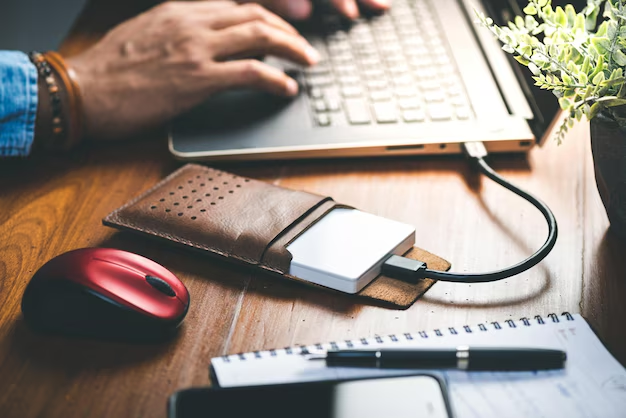Effortless File Transfers: Your Guide to Using Flash Drives with Your Computer
In our increasingly digital world, knowing how to efficiently transfer files from your computer to a flash drive is an invaluable skill. Whether you're safeguarding important documents, sharing content with friends, or managing your digital space, this guide will make the process smooth and straightforward. Gone are the days of worrying about how to safely store or transfer data—embrace the power of modern storage solutions with confidence.
Why Use a Flash Drive? 🌟
Before diving into the how-to guide, let's understand the benefits of using a flash drive:
- Portability: Small, lightweight, and easily pocketable.
- Durability: With no moving parts, flash drives withstand physical stress better than other storage devices.
- Capacity: Available in sizes from a few gigabytes to several terabytes.
- Compatibility: Works with a wide range of devices, including computers, tablets, and TVs.
Getting Started: Choosing the Right Flash Drive
Storage Needs
Determine your storage requirements before purchasing:
- Documents & Small Files: A 4GB to 8GB drive may suffice.
- Photos & Videos: Consider 16GB or higher.
- Large Media or Backups: Opt for 64GB and above.
Speed Matters
Transfer speed is crucial, especially when handling large files:
- USB 2.0: Standard speed, suitable for small file transfers.
- USB 3.0 and 3.1: Faster transfer rates, ideal for large files.
Security Features 🔒
If privacy is a concern, look for drives with encryption and password protection.
Step-by-Step: How to Transfer Files
1. Connect the Flash Drive
- Locate a USB port on your computer. Most laptops and desktops come with multiple ports.
- Insert the flash drive into the USB port. Your computer should automatically recognize it. If not, ensure it's properly inserted.
2. Open File Explorer
Whether you're on Windows or Mac, accessing your file management system is essential:
- Windows Users: Open File Explorer by clicking the folder icon on your taskbar. Locate 'This PC' on the left sidebar.
- Mac Users: Use Finder from your dock or by clicking the desktop.
3. Locate Your Files
- Navigate to the folder where your desired files are stored.
- Select the files you wish to transfer. Hold the Ctrl key (Cmd for Mac) to select multiple files.
4. Drag and Drop Method
- With files selected, drag them to the flash drive listed in the sidebar.
- Drop them in the new window or on the drive's icon.
5. Copy and Paste Method
For an alternative method:
- Right-click the selected files and choose 'Copy.'
- Open the flash drive directory, right-click within the window, and select 'Paste.'
6. Safely Eject the Flash Drive
Prevent data corruption by safely removing your drive:
- Windows: Click the USB or 'Safely Remove Hardware' icon in your taskbar. Select ‘Eject’ for your drive.
- Mac: Drag the drive’s icon to the Trash, which turns into an Eject icon.
Troubleshooting Common Issues
Flash Drive Not Recognized
- Check Physical Connection: Ensure the drive is properly inserted.
- Try Another USB Port: Ports vary in power; switching can solve connectivity issues.
- Update Drivers: On Windows, head to Device Manager and update USB drivers.
Slow Transfer Speeds 🐢
- File Size: Large files take longer. Ensure your expectations align with reality.
- Drive Type: Confirm if the drive is USB 2.0 or 3.0/3.1; the latter offers higher speeds.
- Computer Performance: Close unnecessary applications to free up resources.
Expanding Your Tech Skills
Beyond basic transfers, master these advanced features:
- File Compression: Use tools like WinRAR or 7-Zip to compress large files before transfer.
- Automated Backups: Setup tools that automatically back up files to your flash drive.
- Data Encryption: Enhance security with software encryption to protect sensitive data.
Flash Drive Maintenance Tips
Keep It Clean
- Avoid Exposure: Protect the drive from dust and moisture by using a protective cover.
- Safe Storage: Store in a cool, dry place away from direct sunlight.
Regularly Backup Data
Flash drives, while durable, are not immune to failure. Regularly back up essential data to another device or the cloud.
Format Drives as Needed
If your drive becomes slow or shows errors, consider formatting it:
- Windows: Right-click the drive in File Explorer, select 'Format,' choose settings, and confirm.
- Mac: Use Disk Utility, select the drive, and choose 'Erase' with desired format settings.
Concise Tips for Flash Drive Transfers ✨
- 👾 Keep Ports Clear: Ensure USB ports are free from debris.
- 🔍 Label Drives: Prevent confusion by labeling drives clearly.
- 🗂️ Organize Files: Maintain folder structures for easy navigation.
- 💡 Double-Check Sizes: Before transferring, ensure enough space is available.
In essence, transferring files to a flash drive is a versatile skill with wide applications—from simplifying your digital life to securing data on the go. Whether you're a tech novice or a seasoned expert, these steps are designed to empower you to seamlessly integrate flash drives into your daily routine. Embrace this practical tool to enhance your digital world with ease and efficiency.

Related Topics
- How Can I Transfer Bookmarks From One Computer To Another
- How Can I Transfer Software From One Computer To Another
- How Can You Transfer Files From One Computer To Another
- How Can You Transfer Programs From One Computer To Another
- How Do I Transfer Prescription To Another Pharmacy
- How Do I Transfer Software From One Pc To Another
- How Do You Transfer Bookmarks From One Computer To Another
- How Do You Transfer Files To a Flash Drive
- How Do You Transfer Software From One Computer To Another
- How To Transfer a Capcut Project From Pc To Phone